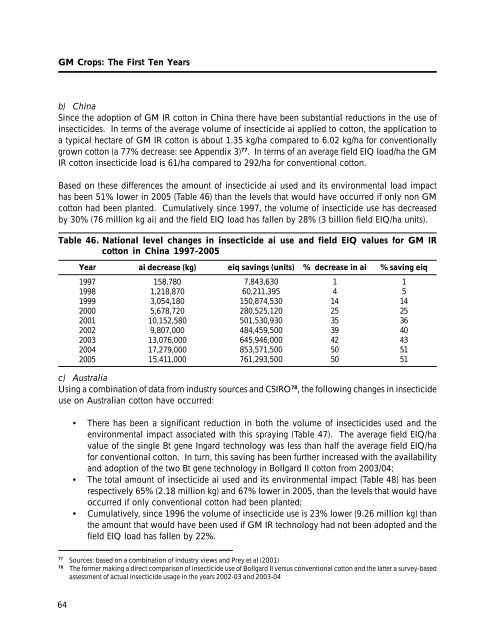GM Crops: The First Ten Years - International Service for the ...
GM Crops: The First Ten Years - International Service for the ...
GM Crops: The First Ten Years - International Service for the ...
You also want an ePaper? Increase the reach of your titles
YUMPU automatically turns print PDFs into web optimized ePapers that Google loves.
<strong>GM</strong> <strong>Crops</strong>: <strong>The</strong> <strong>First</strong> <strong>Ten</strong> <strong>Years</strong><br />
b) China<br />
Since <strong>the</strong> adoption of <strong>GM</strong> IR cotton in China <strong>the</strong>re have been substantial reductions in <strong>the</strong> use of<br />
insecticides. In terms of <strong>the</strong> average volume of insecticide ai applied to cotton, <strong>the</strong> application to<br />
a typical hectare of <strong>GM</strong> IR cotton is about 1.35 kg/ha compared to 6.02 kg/ha <strong>for</strong> conventionally<br />
grown cotton (a 77% decrease: see Appendix 3) 77 . In terms of an average field EIQ load/ha <strong>the</strong> <strong>GM</strong><br />
IR cotton insecticide load is 61/ha compared to 292/ha <strong>for</strong> conventional cotton.<br />
Based on <strong>the</strong>se differences <strong>the</strong> amount of insecticide ai used and its environmental load impact<br />
has been 51% lower in 2005 (Table 46) than <strong>the</strong> levels that would have occurred if only non <strong>GM</strong><br />
cotton had been planted. Cumulatively since 1997, <strong>the</strong> volume of insecticide use has decreased<br />
by 30% (76 million kg ai) and <strong>the</strong> field EIQ load has fallen by 28% (3 billion field EIQ/ha units).<br />
Table 46. National level changes in insecticide ai use and field EIQ values <strong>for</strong> <strong>GM</strong> IR<br />
cotton in China 1997-2005<br />
Year ai decrease (kg) eiq savings (units)<br />
1997<br />
158,780<br />
7,843,630<br />
1998<br />
1,218,870<br />
60,211,395<br />
1999<br />
3,054,180<br />
150,874,530<br />
2000<br />
5,678,720<br />
280,525,120<br />
2001<br />
10,152,580<br />
501,530,930<br />
2002<br />
9,807,000<br />
484,459,500<br />
2003<br />
13,076,000<br />
645,946,000<br />
2004<br />
17,279,000<br />
853,571,500<br />
2005<br />
15,411,000<br />
761,293,500<br />
% decrease in ai<br />
1<br />
4<br />
14<br />
25<br />
35<br />
39<br />
42<br />
50<br />
50<br />
% saving eiq<br />
1<br />
5<br />
14<br />
25<br />
36<br />
40<br />
43<br />
51<br />
51<br />
c) Australia<br />
Using a combination of data from industry sources and CSIRO 78 , <strong>the</strong> following changes in insecticide<br />
use on Australian cotton have occurred:<br />
• <strong>The</strong>re has been a significant reduction in both <strong>the</strong> volume of insecticides used and <strong>the</strong><br />
environmental impact associated with this spraying (Table 47). <strong>The</strong> average field EIQ/ha<br />
value of <strong>the</strong> single Bt gene Ingard technology was less than half <strong>the</strong> average field EIQ/ha<br />
<strong>for</strong> conventional cotton. In turn, this saving has been fur<strong>the</strong>r increased with <strong>the</strong> availability<br />
and adoption of <strong>the</strong> two Bt gene technology in Bollgard II cotton from 2003/04;<br />
• <strong>The</strong> total amount of insecticide ai used and its environmental impact (Table 48) has been<br />
respectively 65% (2.18 million kg) and 67% lower in 2005, than <strong>the</strong> levels that would have<br />
occurred if only conventional cotton had been planted;<br />
• Cumulatively, since 1996 <strong>the</strong> volume of insecticide use is 23% lower (9.26 million kg) than<br />
<strong>the</strong> amount that would have been used if <strong>GM</strong> IR technology had not been adopted and <strong>the</strong><br />
field EIQ load has fallen by 22%.<br />
77 Sources: based on a combination of industry views and Prey et al (2001)<br />
78 <strong>The</strong> <strong>for</strong>mer making a direct comparison of insecticide use of Bollgard II versus conventional cotton and <strong>the</strong> latter a survey-based<br />
assessment of actual insecticide usage in <strong>the</strong> years 2002-03 and 2003-04<br />
64
















